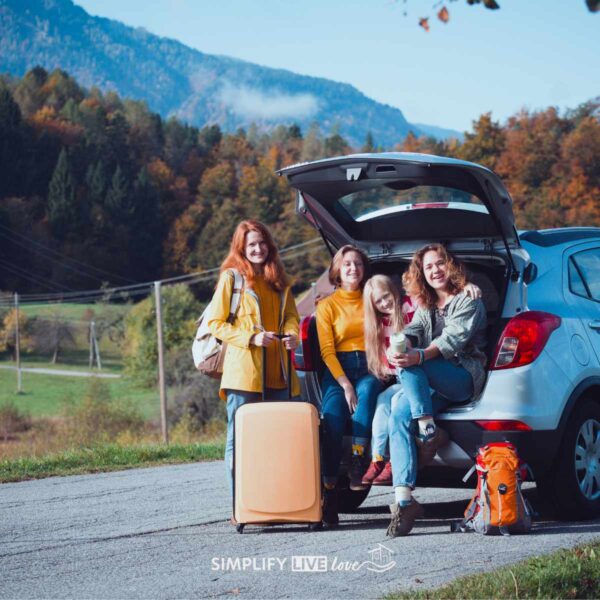One Day at Hawai’i Volcanoes National Park for Families
on Apr 11, 2024
This post may contain affiliate links. Please read our disclosure policy.
Here are our tried and true tips & tricks, our favorite family-friendly trails and viewpoints for a fantastic family day trip to Hawaii Volcanoes National Park.
One activity you cannot miss when you visit the Big Island of Hawaii is visiting Hawai’i Volcanoes National Park. The whole family will enjoy the sights and sounds of this living, breathing volcanic landscape on some of the world’s most active volcanoes found right on Hawaii’s Big Island.

The Highlights
If you don’t have time to read the whole post, here are the highlights:
Hawaii Volcanoes National Park is located on the Big Island of Hawaii about 30 miles southwest of Hilo and 96 miles southeast of Kailua-Kona.
Pack – Take snacks and wear layers. Don’t forget rain jackets, mineral sunscreen, hats, sturdy shoes.
Must Visit – Thurston Lava Tube, Halema’uma’u Crater, Holei Sea Arch, Pu’uloa Petroglyphs
When to go – The park is less crowded during the afternoons and evenings. Plan for dusk or sunset if you’d like to see lava glows. Plan for dark for great views of the stars.
Where to stay – Stay on the Hilo side if you like rainforests and hiking. Stay on the Kona side if you prefer drier weather and want to be closer to golf and beaches.
Ancient lava tubes, volcanic craters, lush rainforests full of native plants, rainbows, petroglyphs, and an ever-changing landscape thanks to recent lava flows are some of the main attractions you’ll find when you visit this amazing place.
Here’s what to know and how to make the most of a full day when you visit this amazing volcano national park. Do not skip this day when you visit the beautiful Big Island of Hawaii.

Where is Hawai’i Volcanoes National Park?
Hawaii Volcanoes National Park a US National Park that preserves and protects the deep heritage and biodiversity of Hawaii, also named a World Heritage Site and an International Biosphere Reserve.
If you’re trying to get to all of the 63 US National Parks, here are a few others that we’ve been too:
Hot Springs National Park, Arkansas
Gateway Arch National Park, St. Louis
Badlands National Park, South Dakota
Table of Contents
- The Highlights
- Where is Hawai’i Volcanoes National Park?
- Helpful Tip
- When is the Best Time to Visit Hawai’i Volcanoes National Park?
- What is Hawai’i Volcanoes National Park Weather Like?
- The History of Hawaii Volcanoes National Park
- Best Way to Spend a Day at Hawaii Volcanoes National Park
- Fun Fact
- Pu’U Loa Trail to the Petroglyphs
- Devastation Trail
- The Nahuku Thurston Lava Tube
- Lava Tube Tip
- Eat at The Rim Restaurant
- Ready to travel? Use these helpful links to book your stay!
Hawai’i Volcanoes National Park is located on the Big Island of Hawaii about 30 miles southwest of Hilo and 96 miles southeast of Kailua-Kona. We drove on the Saddle Road, Route 200, from the Kona side through Waikoloa and Hilo.
We made the drive on Saddle Road which cuts through the middle of the island, connecting the east and west sides. This road is the fastest way to get from east to west. It’s pretty remote and dark as it passes between the two largest mountains on the Big Island, Mauna Loa (13,680 feet) and Mauna Kea (13,796 feet). It takes about 2 hours to get from one side to the other using the Saddle Road.
Helpful Tip
Make sure you have a full tank of gas, snacks, and an empty bladder when you take this route because once you leave Waikoala or Hilo, there is nowhere to stop along the way. In fact, we had to turn around and head back to Hilo when it looked like we wouldn’t have enough gas to make the trip. There’s also very limited cell service on this route so getting stuck would not be a good idea.

When is the Best Time to Visit Hawai’i Volcanoes National Park?
The best time to visit Hawai’i Volcanoes National Park depends on your interests, tolerance for crowds, and the experiences you hope to have. Each season offers its own unique charms, whether it’s clear skies for volcano viewing, blooming wildflowers, or peaceful trails for hiking.
If you’re hoping to see an active lava flow, keep in mind that volcanic activity can change, and lava viewing isn’t guaranteed. Check with the park’s visitor center for updates. There were no active lava flows when we visited, but they do happen a lot.
If there is an active lava flow when you visit, you might want to be there after dark. The glows are supposed to be fantastic! We had planned to be at the park for sunset, but lack of lava flow changed our minds. However, the park’s remote location also makes it an excellent spot for stargazing so you might want to be there at night.
What is Hawai’i Volcanoes National Park Weather Like?
The weather at Hawai’i Volcanoes National Park varies widely depending on where you are. The day we went, we experienced cool and misty near the visitor’s center and hot and windy as we drove down Crater Rim Drive toward the petroglyphs and the Sea Arch.
You’ll want to be prepared for a mix of microclimates depending on where you are in the park so wear layers and bring a rain jacket!

Tips for Visiting this International Biosphere Reserve
Not only are you visiting one of 63 US National Parks, but you’ll also be at one of only 28 International biosphere reserve areas in the US.
Layer Up: Due to the varied weather conditions, it’s best to dress in layers that can be added or removed as needed.
Waterproof Gear
Carry a waterproof jacket or poncho, especially for misty conditions around the crater rim.
Sun Protection
Even on cloudy days, UV rays can be strong, so wear sunscreen, sunhats, and sunglasses. Remember, Hawaii has banned most commercial sunscreens because the chemicals bleach and kill the corals. Make sure to bring only mineral sunscreen for your trip to the Hawaiian Islands.
Sturdy Footwear
If you plan to hike, wear sturdy, closed-toe shoes with good traction. I took these Vasque Re:Connect – Now lightweight shoes and they were perfect!
Check Conditions
Before heading out, check with the park’s visitor center for the latest weather updates and trail conditions.

The History of Hawaii Volcanoes National Park
Established in 1916, Volcanoes National Park is one of the oldest parks in the National Park System. It was created not only to protect the many endemic and indigenous flora and fauna unique to Hawaii, but also the many stunning geological features and cultural sites.
Initially, the park only included the summits of Kilauea and Mauna Loa volcanoes, but it has since expanded to include a larger area of the island’s volcanic region. Five different volcanoes make up this amazing volcano national park.
According to Hawaiian mythology, the craters of Kilauea are home to the goddess of fire, lightning, wind, dance, and volcanoes, Pele, (pronounced peh-leh). Her poetic name is Ka wahine ‘ai hōnua, the woman who devours the earth, and you can see her work in action when you visit. Kilauea Volcano is the youngest volcano in Hawaii. According to the NPS, it formed underwater 280,000 years ago.
You’ll also find the largest active volcano in the world here, Mauna Loa, which rises more than 30,000 from the ocean floor! That means it’s technically 27,000 feet taller than Mount Everest!
In addition to these two active volcanoes, three more mostly inactive volcanoes, Mauna Kea, Hualālai, and Kohala, make up Volcanoes National Park.
Over the years, the park has had numerous volcanic eruptions that are continuously forming new land on the island of Hawaii. One of the most significant eruptions happened in 1959 when a massive eruption from Kilauea’s Mauna Ulu vent created new land along the coastline, forever changing the island’s geography.
The latest eruption was a six day event in September of 2023. When we went in March of 2024, there weren’t any active eruptions to see.

Best Way to Spend a Day at Hawaii Volcanoes National Park
Start at the Kilauea Visitor Center
We always recommend starting your visits at any national park at the visitor center. The Kilauea Visitor Center is the perfect place to take a bathroom break, fill up water bottles, check out the exhibits, watch the short park movies, grab a junior ranger booklet, and get tips from the park rangers about volcanic activity and timing for more popular sites.
Make sure to stop in here to get your passport stamped and to buy any official park souvenirs as well.
Pin this now to find it later
Pin It
Kilauea at Halema’uma’u Crater
Definitely go to the overlook and check out the Halema’uma’u Crater. Not too long ago there was a lake here, but that is gone now. You can still marvel at its size and see steam rising from steam vents. It was misty and chilly the day we were there and it was fun to warm up at the steam vents near the parking lot.
Fun Fact
Remember, this is the home of Pele. If your kids are fans of Disney’s Moana, they’ll know about Pele.

Drive the Scenic Chain of Craters Road
Enjoy breathtaking views along this winding road, as you descend 3,700 feet to the coast, almost to sea level. You start out in the jungle and end up at the ocean, passing through all different ages of lava fields. It’s a little surreal and something you will not want to miss.
Chain of Craters Road is 18.8 miles out to the Holei Sea Arch. There’s no food, water, or gas so make sure you take what you need when you head out. You’ll find vault-type toilets at the Maunaulu parking area and at the end of the road.

As you drive the road, make sure to stop at overlooks, hike out to see the ancient petroglyphs, and check out the Holei Sea Arch.
As you wind towards the coast, the coastal views and changing weather patterns can also create stunning rainbow displays so keep your eyes open!

Pu’U Loa Trail to the Petroglyphs
This trail is rated easy, but make sure you’re wearing sturdy shoes. It’s over very uneven terrain and is windy and hot.
Once you get to the petroglyphs, there’s a boardwalk trail. But the .7 mile walk out to the petroglyphs is bumpy, uneven, and there’s no shade.

Make sure to wear a hat and take water when you do this 1.4 mile round trip hike. We enjoyed this hike, but noticed it was hard for elderly people and people with mobility issues.

Devastation Trail
Devastation Trail is a half-mile relatively easy, paved walk suitable for visitors of all ages and abilities. The trail starts out in a forest and then winds through a stark landscape of cinder and ash, leftover from the historic 37 day eruption of Kilauea Iki Crater in 1959.
We loved the trail for its out of this world quality. As you walk down the path, the first thing you notice is how barren the landscape looks. But then you start to notice all of the growth. If you look closely, you’ll see lots of red ohelo berries which the nene, food for the endangered native Hawaiian goose.
You’ll also see the resilient ‘ōhi’a trees, with their vibrant green leaves and delicate red blossoms, beginning to reclaim the land. These hardy trees are among the first to establish themselves in the nutrient-rich volcanic soil, paving the way for plants and animals to slowly retake the area.

The Nahuku Thurston Lava Tube
One of the most popular things to do at Volcano National Park is to venture underground into a natural lava tube. Formed by ancient lava flows, it’s a short walk among beautiful flora and fauna of the native forest. Once you get there, you’ll see eerie rock formations and an amazing lava tube. Be respectful of the site and don’t touch the walls or hanging roots.
Lava Tube Tip
You might chose to visit the lava tube later in the day. It’s a really popular stop and the Lava Tube parking lot is very full earlier in the day. If you want to avoid parking there, you can park at Kilauea Iki Overlook and take a 1.5 mi round-trip walk from there.
Eat at The Rim Restaurant
Eat at a meal at The Rim or stay in the historic park hotel, the Volcano House where the backdrop includes the Kilauea caldera and the Halema’uma’u Crater. Make a dining reservation here.
Now that you’re inspired to visit Hawai’i Volcanoes National Park, what are you most excited to see?
Ready to travel? Use these helpful links to book your stay!
- Book your plane ticket with Expedia or Kayak
- Find a reasonably priced rental car or an RVShare rental for the perfect road trip
- Get your Harvest Hosts membership so you can camp at farms, wineries, breweries and more!
- We love using Hotels.com or Vrbo for the perfect home away from home
- Save on tickets to attractions, sightseeing tours, and more with TripAdvisor, CityPASS, Big Bus Tours, and Viator
- Don’t leave home without travel insurance to protect your trip!
- Check out our favorite 21 Time and Money Saving Travel Apps
- Get a National Park Pass to keep or gift













